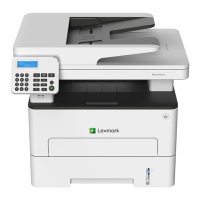Using a flash drive
This option is available only in printer models with front USB port.
Make sure to enable the Enable Drive and Update Code settings. You can
find
the settings in the Flash drive
menu under the Settings menu.
1 Insert the flash drive into the USB port.
2 From the control panel, navigate to USB Menu: Print from USB > Accept or OK.
3 Select the file that you need to flash.
Note: Do not turn
o
the printer while the update is going on.
Using a network computer
Using the File Transfer Protocol (FTP)
Make sure that the printer is in ready state before
flashing
the printer.
1 Turn on the printer.
2 Obtain the IP address:
• From the home screen
• From the TCP/IP section of the Network/Ports menu
3 From the command prompt of a network computer, open an FTP session to the printer IP address.
4 Use a PUT command to place the
firmware
file
on the printer.
The printer performs a POR sequence and terminates the FTP session.
5 Repeat step 2 through step 4 for the other files.
Using the Embedded Web Server
Make sure that the printer is in ready state before flashing the printer.
1 Open a web browser, and then type the printer IP address.
2 From the home page, navigate to Configuration > Update Firmware.
3 Select the file to use.
The printer performs a POR sequence and terminates the FTP session.
4 Repeat step 2 through step 4 for the other files.
Backing up eSF solutions and settings
Note: Export the eSF solutions and settings from the printer before replacing the controller board.
Exporting eSF solutions and settings file
1
Reset the printer into Invalid engine mode. See “Entering Invalid engine mode” on page 199.
2 Open a web browser, and then type the printer IP address.
Note: If the web page cannot be accessed or an error occurs when starting the printer into Invalid engine
mode, then data backup is not an option. Inform the customer that the data cannot be saved.
3400-48x
Parts removal
212

